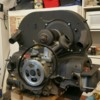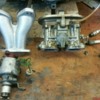The good news is that they’re really simple engines that come apart/go back together really well. Grab a Bentleys or Chilton’s manual, or Tom Wilson’s book, “How to Rebuild your Volkswagen Engine off of Amazon and follow that for the rebuild (personally, I like Tom’s book)
You shouldn't need a gasket between case halves unless it has been “O-Ringed” between the case halves. If it has been, get on here and you’ll get half a dozen different ways to seal the o-ring space.  Or, just shoot the groove with Permatex and rave on.
Or, just shoot the groove with Permatex and rave on.
Also remember that these are NOT “American” engines. They were designed and assembled by OCD German people. That means that if you feel you need to apply force to get things to go together, something’s wrong. They were designed to fit properly together without forcing anything.
Good luck, and keep us posted. I wanna know what’s going on in there, at least!




